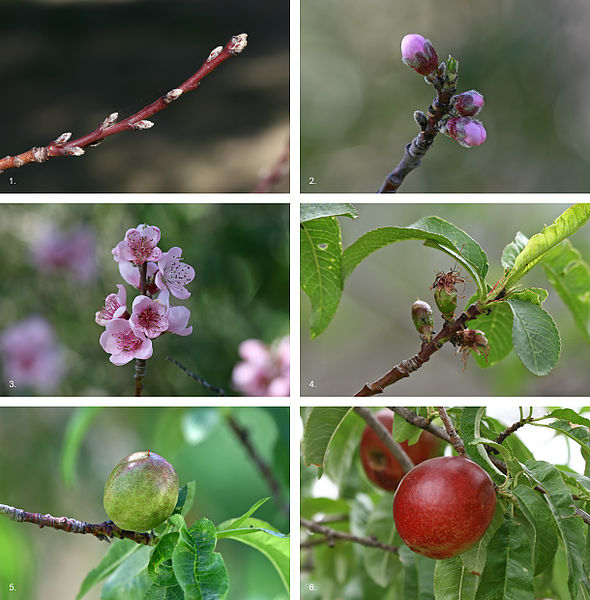Fails:Nectarine Fruit Development.jpg

Šī priekšskata izmērs: 590 × 600 pikseļi. Citi izmēri: 236 × 240 pikseļi | 472 × 480 pikseļi | 756 × 768 pikseļi | 1 007 × 1 024 pikseļi | 2 440 × 2 480 pikseļi.
Pylnā lelumā (2 440 × 2 480 pikseli, faila izmārs: 919 KB, MIME tips: image/jpeg)
Faila viesture
Spīd iz datums/laiks kolonā īlyktuos saitis, kab apsavārtu, kai itais fails izavēre tūlaik.
| Data/Laiks | Miniatura | Izmāri | Lītuotuojs | Komentars | |
|---|---|---|---|---|---|
| tagadejais | 2008. gada 6. vosorys mieness, plkst. 14.21 |  | 2 440 × 2 480 (919 KB) | Jjron | {{Information |Description=Nectarine (''Prunus persica'') fruit development over a 7½ month period, from early winter to midsummer; East Gippsland, Victoria, Australia. #Bud formation can be observed on new growth on the plant (early winter) ([[:Image:0 |
| 2008. gada 6. vosorys mieness, plkst. 14.14 |  | 2 440 × 2 480 (919 KB) | Jjron | {{Information |Description=Nectarine (''Prunus persica'') fruit development over a 7½ month period, from early winter to midsummer; East Gippsland, Victoria, Australia. #Bud formation can be observed on new growth on the plant (early winter) ([[:Image:0 | |
| 2008. gada 24. pavasara mieness, plkst. 16.00 |  | 2 440 × 2 480 (993 KB) | Jjron | {{Information |Description=Nectarine fruit development over a 4½ month period, from early September 2007 to mid January 2008; East Gippsland, Victoria, Australia. #. Flower buds form and leaves start to develop.<br> #. Flowers fully develop and are poll |
Failu saitis
Itamuos 1 lopuos ir saite iz itū failu:
Globālais faila lietojums
Šīs Vikipēdijas izmanto šo failu:
- Izmantojums arc.wikipedia.org
- Izmantojums ar.wikipedia.org
- Izmantojums ast.wikipedia.org
- Izmantojums ast.wiktionary.org
- Izmantojums ba.wikipedia.org
- Izmantojums be-tarask.wikipedia.org
- Izmantojums bg.wikipedia.org
- Izmantojums bn.wikipedia.org
- Izmantojums bo.wikipedia.org
- Izmantojums bs.wikipedia.org
- Izmantojums crh.wikipedia.org
- Izmantojums cv.wikipedia.org
- Izmantojums diq.wikipedia.org
- Izmantojums dsb.wikipedia.org
- Izmantojums en.wikipedia.org
- Fruit
- Peach
- Drupe
- Prunus
- User:Jjron
- User talk:Jjron/Archive 3
- Wikipedia:Featured pictures thumbs/11
- Wikipedia:Featured pictures/Plants/Fruits
- Wikipedia:Featured picture candidates/June-2008
- Wikipedia:Featured picture candidates/Image:Nectarine Fruit Development.jpg
- Wikipedia:Wikipedia Signpost/2008-06-23/Features and admins
- User:Jjron/Gallery/Plants
- User:Jjron/Gallery/FPs
- Wikipedia:Wikipedia Signpost/2008-06-23/SPV
- Wikipedia:Picture of the day/December 2008
- Template:POTD/2008-12-11
- Wikipedia talk:2008 main page redesign proposal/Archive 4
- Wikipedia:WikiProject Food and drink/Recognized content
- Wikipedia:WikiProject Food and drink/Showcase
- Wikipedia:WikiProject Food and drink/Showcase/FM
- Wikipedia:WikiProject Food and drink/Showcase/POTD
- User:Abyssal/bla
- Wikipedia:WikiProject Plants/Recognized content
- Portal:Plants/Recognized content
- User:Haoreima/List of Meitei plant common names
- Wikipedia:Wikipedia Signpost/Single/2008-06-23
- Izmantojums en.wikiversity.org
- Izmantojums eo.wikipedia.org
- Izmantojums es.wikipedia.org
- Izmantojums fa.wikipedia.org
Skatīt šī faila pilno globālo izmantojumu.


